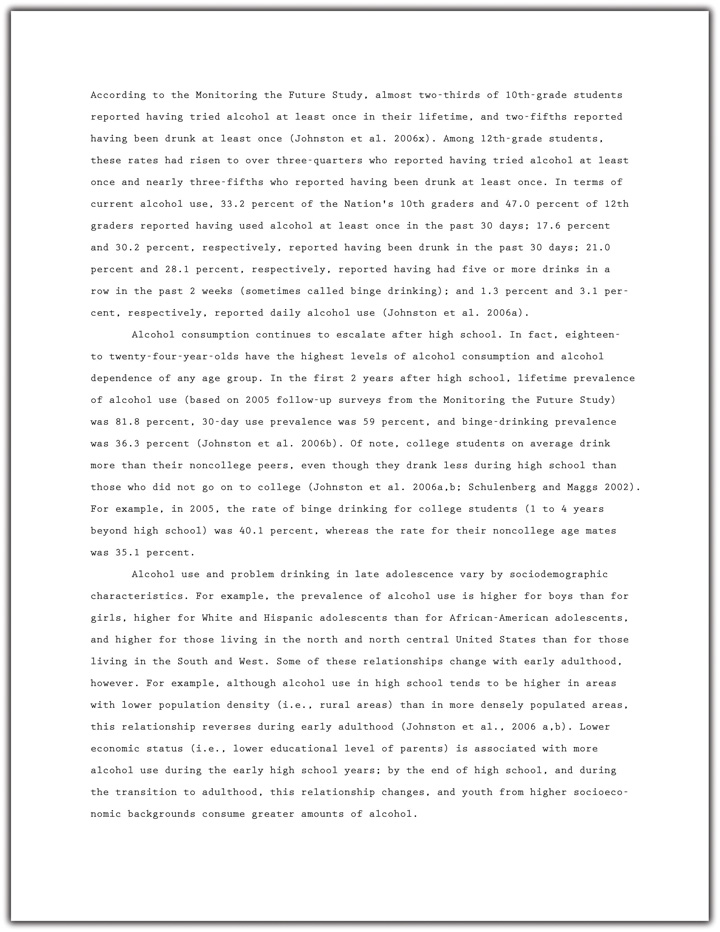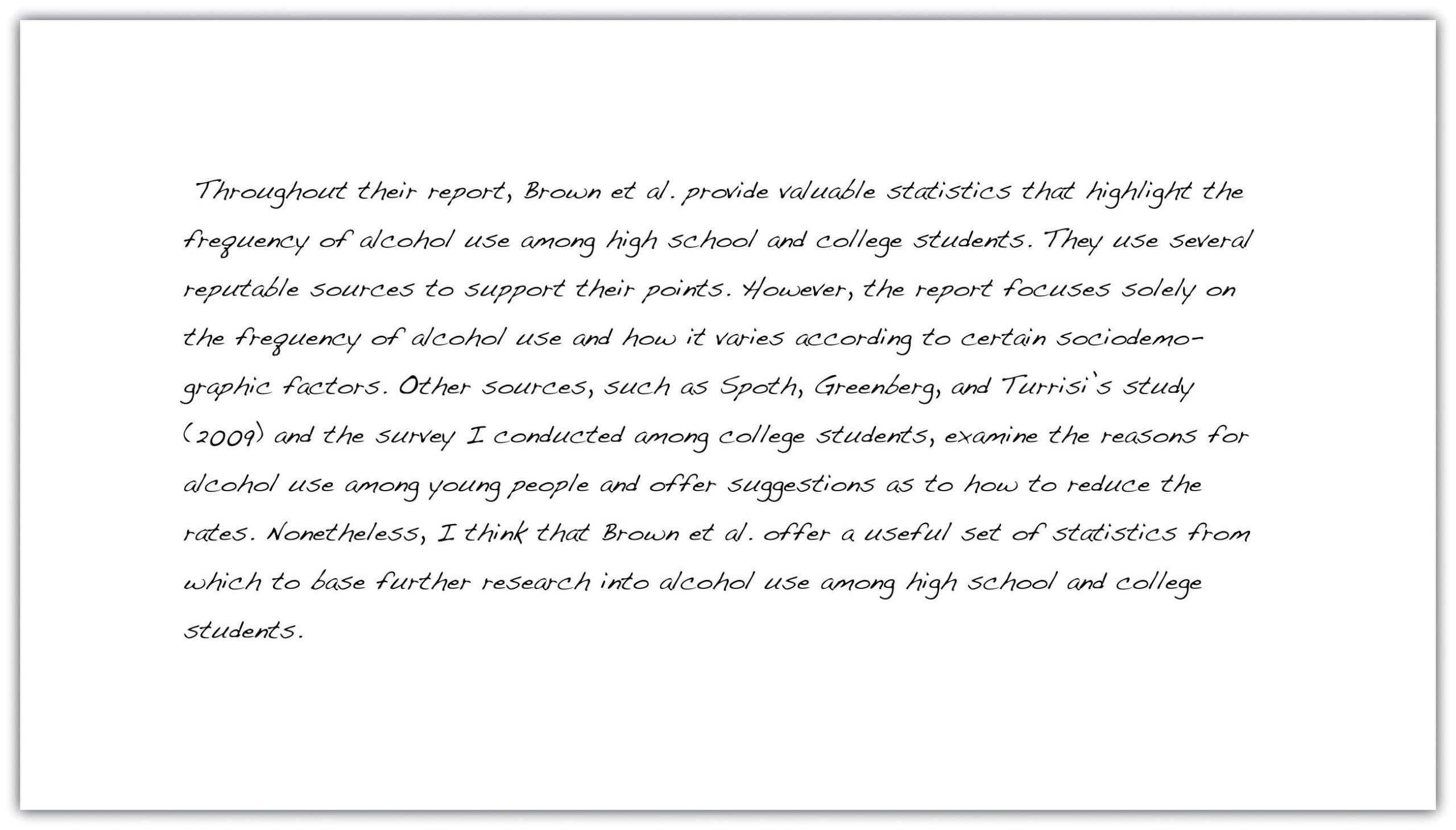4 Types of Paragraphs
Summary Paragraphs
A summary shrinks a large amount of information into only the essentials. You probably summarize events, books, and movies daily. Think about the last blockbuster movie you saw or the last novel you read. Chances are, at some point in a casual conversation with a friend, coworker, or classmate, you compressed all the action in a two-hour film or in a two-hundred-page book into a brief description of the major plot movements. While in conversation, you probably described the major highlights, or the main points in just a few sentences, using your own vocabulary and manner of speaking.
Similarly, a summary paragraph condenses a long piece of writing into a smaller paragraph by extracting only the vital information. A summary uses only the writer’s own words. Like the summary’s purpose in daily conversation, the purpose of an academic summary paragraph is to maintain all the essential information from a longer document. Although shorter than the original piece of writing, a summary should still communicate all the key points and key support. In other words, summary paragraphs should be succinct and to the point.
A summary of the report should present all the main points and supporting details in brief. Read the following summary of the report written by a student:
Notice how the summary retains the key points made by the writers of the original report but omits most of the statistical data. Summaries need not contain all the specific facts and figures in the original document; they provide only an overview of the essential information.
Analysis Paragraphs
An analysis separates complex materials in their different parts and studies how the parts relate to one another. The analysis of simple table salt, for example, would require a deconstruction of its parts—the elements sodium (Na) and chloride (Cl). Then, scientists would study how the two elements interact to create the compound NaCl, or sodium chloride, which is also called simple table salt.
Analysis is not limited to the sciences, of course. An analysis paragraph in academic writing fulfills the same purpose. Instead of deconstructing compounds, academic analysis paragraphs typically deconstruct documents. An analysis takes apart a primary source (an essay, a book, an article, etc.) point by point. It communicates the main points of the document by examining individual points and identifying how the points relate to one another.
Take a look at a student’s analysis of the journal report.
Notice how the analysis does not simply repeat information from the original report, but considers how the points within the report relate to one another. By doing this, the student uncovers a discrepancy between the points that are backed up by statistics and those that require additional information. Analyzing a document involves a close examination of each of the individual parts and how they work together.
Synthesis Paragraphs
A synthesis combines two or more items to create an entirely new item. Consider the electronic musical instrument aptly named the synthesizer. It looks like a simple keyboard but displays a dashboard of switches, buttons, and levers. With the flip of a few switches, a musician may combine the distinct sounds of a piano, a flute, or a guitar—or any other combination of instruments—to create a new sound. The purpose of the synthesizer is to blend together the notes from individual instruments to form new, unique notes.
The purpose of an academic synthesis is to blend individual documents into a new document. An academic synthesis paragraph considers the main points from one or more pieces of writing and links the main points together to create a new point, one not replicated in either document.
Take a look at a student’s synthesis of several sources about underage drinking.
Notice how the synthesis paragraphs consider each source and use information from each to create a new thesis. A good synthesis does not repeat information; the writer uses a variety of sources to create a new idea.
Evaluation Paragraphs
An evaluation judges the value of something and determines its worth. Evaluations in everyday experiences are often not only dictated by set standards but also influenced by opinion and prior knowledge. For example, at work, a supervisor may complete an employee evaluation by judging his subordinate’s performance based on the company’s goals. If the company focuses on improving communication, the supervisor will rate the employee’s customer service according to a standard scale. However, the evaluation still depends on the supervisor’s opinion and prior experience with the employee. The purpose of the evaluation is to determine how well the employee performs at his or her job.
An academic evaluation communicates your opinion, and its justifications, about a document or a topic of discussion. Evaluations are influenced by your reading of the document, your prior knowledge, and your prior experience with the topic or issue. Because an evaluation incorporates your point of view and reasons for your point of view, it typically requires more critical thinking and a combination of summary, analysis, and synthesis skills. Thus evaluation paragraphs often follow summary, analysis, and synthesis paragraphs. Read a student’s evaluation paragraph.
Notice how the paragraph incorporates the student’s personal judgment within the evaluation. Evaluating a document requires prior knowledge that is often based on additional research.
Tip
When reviewing directions for assignments, look for the verbs summarize, analyze, synthesize, or evaluate. Instructors often use these words to clearly indicate the assignment’s purpose. These words will cue you on how to complete the assignment because you will know its exact purpose.
Exercise 1
Read the following paragraphs about four films and then identify the purpose of each paragraph.
- This film could easily have been cut down to less than two hours. By the final scene, I noticed that most of my fellow moviegoers were snoozing in their seats and were barely paying attention to what was happening on screen. Although the director sticks diligently to the book, he tries too hard to cram in all the action, which is just too ambitious for such a detail-oriented story. If you want my advice, read the book and give the movie a miss.
- During the opening scene, we learn that the character Laura is adopted and that she has spent the past three years desperately trying to track down her real parents. Having exhausted all the usual options—adoption agencies, online searches, family trees, and so on—she is on the verge of giving up when she meets a stranger on a bus. The chance encounter leads to a complicated chain of events that ultimately result in Laura getting her lifelong wish. But is it really what she wants? Throughout the rest of the film, Laura discovers that sometimes the past is best left where it belongs.
- To create the feeling of being gripped in a vice, the director, May Lee, uses a variety of elements to gradually increase the tension. The creepy, haunting melody that subtly enhances the earlier scenes becomes ever more insistent, rising to a disturbing crescendo toward the end of the movie. The desperation of the actors, combined with the claustrophobic atmosphere and tight camera angles create a realistic firestorm, from which there is little hope of escape. Walking out of the theater at the end feels like staggering out of a Roman dungeon.
- The scene in which Campbell and his fellow prisoners assist the guards in shutting down the riot immediately strikes the viewer as unrealistic. Based on the recent reports on prison riots in both Detroit and California, it seems highly unlikely that a posse of hardened criminals will intentionally help their captors at the risk of inciting future revenge from other inmates. Instead, both news reports and psychological studies indicate that prisoners who do not actively participate in a riot will go back to their cells and avoid conflict altogether. Examples of this lack of attention to detail occur throughout the film, making it almost unbearable to watch.
Collaboration
Share with a classmate and compare your answers.
Writing at Work
Thinking about the purpose of writing a report in the workplace can help focus and structure the document. A summary should provide colleagues with a factual overview of your findings without going into too much specific detail. In contrast, an evaluation should include your personal opinion, along with supporting evidence, research, or examples to back it up. Listen for words such as summarize, analyze, synthesize, or evaluate when your boss asks you to complete a report to help determine a purpose for writing.






